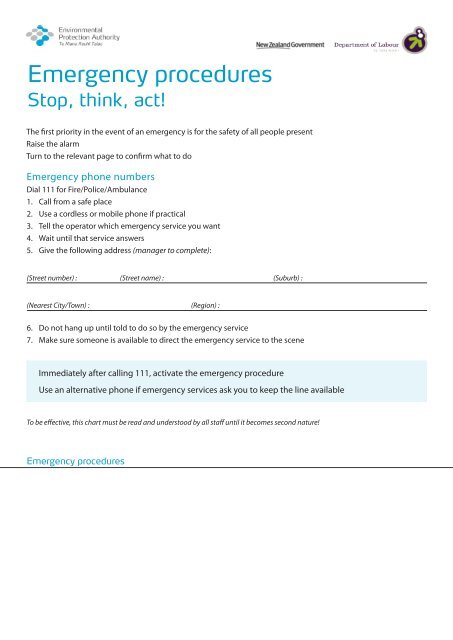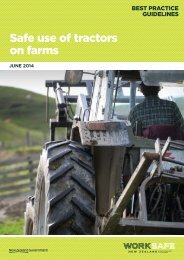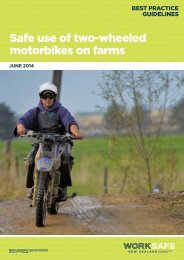Emergency-procedures-flipchart
Emergency-procedures-flipchart
Emergency-procedures-flipchart
You also want an ePaper? Increase the reach of your titles
YUMPU automatically turns print PDFs into web optimized ePapers that Google loves.
Fire and emergency <strong>procedures</strong> checklistYou must know and understand what to do if a fire occursYour first concern is the immediate safety of all people presentNext call emergency servicesContain the fire but only if it is safe to do soIf help is available, allocate responsibilities to others to create a competent fire fighting teamFire emergency checklist1. Raise the alarm2. Evacuate people from the area3. Activate any emergency shut down systems4. Call emergency services (dial 111)5. Call your managerPrecautionsDo not endanger yourselfMake sure you have an escape routeDo not use water on petroleum or electrical firesDo not leave the site unattended if there is arisk of further outbreakAdvise your manager of the incidentEvacuation/assembly points (manager to complete):Location of nearest phones (manager to complete):
LPG leak checklistYou must know and understand what to do if a leak occursYour first consideration is the immediate safety of all people presentNext call emergency servicesContain the leak but only if it is safe to do soIf help is available, allocate responsibilities to others to create a competent emergency team to deal with the leakGas leak checklist bulk facility1. Raise the alarm2. Evacuate people from the area3. Activate any emergency shut down systems4. Activate any water spray protection systems5. Call emergency services (dial 111)6. Call your managerPrecautionsDo not endanger yourselfMake sure you have an escape routeKeep hands and face clear of any escapinggas or liquidNo smoking. Keep ignition sources at least20 metres away until the area is safeDo not use equipment again until it has beeninspectedDo not leave the site unattended if there is arisk of a further leakAdvise your manager of the incidentEvacuation/assembly points (manager to complete):Location of nearest phones (manager to complete):
Leak suspected with cylinder or applianceIf there is any possibility of cylinder(s) being engulfed by fire, evacuate adjacent areasCall the Fire Service, advise the location of the cylinder or appliance, that it is LPG and the cylinder sizeKeep cylinder cool with a water hose, sprayed from maximum possible distanceRemove or extinguish sources of ignitionRemove from heat source if it is possible and safe to do soStop the leak by shutting the cylinder valve if it is safe to do soDo not interfere with any part of a fixed installationIf gas is leaking ventilate the area thoroughly until the air is clearIf the leak persists, remove the cylinder to a safe outdoor area if it is safe to do soIf it is a minor leak, check the system for any indication of gas, such as a smell or hissTest with soapy water solution, which will bubble at any point where gas escapesIf a leak is found at a connection, re-make the connection and test againDo not use the cylinder or appliance again until inspectedBulk storage system leakActivate alarm, evacuate the areaCall the Fire ServiceRemove all sources of ignitionActivate any fire protection systemsIf a pipeline leak, close isolation valves, if it is safe to do soAfter the eventComplete an incident reportReview the effectiveness of the emergency planLPG gas leak
Cardio-pulmonary resuscitation (CPR)Danger:Response:Send for Help:Airway:Breathing:CPR:Defibrillate:Check for the safety of yourself, the casualty and bystandersCheck for response, tap the casualty, gently shake and shoutPhone 111 and ask for an ambulanceOpen airway, tilt head backIf not breathing normally start CPRStart CPR, 30 chest compressions, two breathsIf you have a defibrillator and been trained in its use, attach an AED and follow the machine prompts(manager to complete) :First aiders trained in CPR:Doctor:The medical centre is:To check for normal breathing1. Tilt head back and raise chin forward2. Checking for normal breathinga. Look for movementb. Listen for breathingc. Feel for breath on your cheekd. If casualty is not breathing normally, turn on back, start CPR
3. CPRFirst - Position hands in centre of chest, push down firmly and quickly 30 timesa. Breathing: With head tilted back, pinch nose and seal your mouth over patient’s mouth. Blow twice intocasualty’s mouth.Take care if poisoning is suspected. Make sure there is no residual poison in the mouth, consider mouth tonose resuscitationb. Chest Compressions: Push down on chest firmly and quickly 30 timesContinue with two breaths and 30 pumps until help arrivesCall, pump, blowCALLDial 111PUMPPosition hands inthe centre of thechestFirmly push downfive centimetres onthe chest 30 timesBLOWTilt headLift chinCheck breathingGive two breaths.Continue with 30pumps and twobreaths until helparrivesIf reluctant to give mouth to mouth, continue with chest compressionsCPR is needed if a patient has collapsed, is not responsive and is not breathing normallyCasualties who have collapsed should be carefully assessed to decide what emergency care is neededChest compressions are the most important part of CPRIf for any reason you cannot give rescue breaths to a patient, DO attempt chest compressionsCardio-pulmonary resuscitation (CPR )
<strong>Emergency</strong> first aidHave the product label or safety data sheet available and read the instructions on what to do in an emergency(manager to complete) :First aid kits are located at:The medical centre is:First aiders:Doctor:Poison centre: 0800 POISON / 0800 764 766Control of bleeding1. Apply direct pressure to wound – use your hand(s)(wear gloves)2. Elevate (raise) the limb3. Apply a pad and firm bandage4. If necessary use clean rags or clothingRememberAlways check circulation below the bandageIf there is tingling, numbness or blueness, loosen thebandagePoisoning1. Seek medical advice or call an ambulanceRememberDo not make the person vomit without advice from amedical professionalDo not give fluids without advice from a medicalprofessionalForeign bodies in the eye(s)1. Wash the eye(s) with clean cool water2. If the foreign body is stuck to the eye surface,do not attempt to remove it3. Place a covering over both eyes and send for, or takethe person to, medical aidChemicals in the eye(s)1. Wash the eye(s) with clean cool water for at least15 minutes2. Wash from near the nose outwards and always washunder the upper eyelid3. Send for, or take the person to, medical aid
Management of minor wounds1. Clean the wound with soap and water2. Cover lightly with clean dressing3. Seek medical help, if necessaryBreathing difficulties1. If a person is breathing but unconscious, turn themonto their side2. Clear airway of obstructions, such as tongue or vomit3. Seek medical help, if necessaryManagement of burns1. Cool the burnt area with cool water for 10-15 minutes2. If necessary, cover the burn with a clean dressing orplastic wrap before removing person to medical aidRememberDo not burst blistersDo not remove clothing that is stuckDo not apply creamsManagement of chemical burns1. Protect yourself from the substance2. Avoid skin and eye contact3. Brush off dry chemicals, flush liquids from the skinusing cool running water for 15 minutes or more4. Remove any contaminated clothing5. Treat for shock if faint, pale, shallow, rapid breathing6. Wrap area with a dry sterile dressing or clean cloth7. Protect from pressure and friction8. If the skin has blisters or if there is an overall bodyreaction, get medical help immediatelyYour first aid kit containsItem Date checked Date checked Date checked Date checked<strong>Emergency</strong> first aid
When disaster strikesTurn on your radio for advice and informationKnow the civil defence warning signalKnow your nearest civil defence post and police stationDo not go sightseeingCivil defence (manager to complete)Your civil defence warning signal is:Your nearest civil defence post is at:Your nearest police station is at:Your local radio station is:Your civil defence cabinet/kit is at:EarthquakeDuring the earthquakeKeep calmStay indoors where practicalKeep away from windows and heavy furnitureTake cover – use a doorway or get under a strong tableor other sturdy structureAfter the earthquake, if the building is damagedTurn off water, electricity and gas at mainsConserve your waterTreat injuriesGet in touch with neighbours – they may need helpWhen help is needed go to your nearest civildefence postAdvise manager of damage sustained
Tsunami (manager to complete)This business is in a tsunami risk zoneYes NoVolcanic eruption (manager to complete)What warning systems are in place:What warning systems are in place:Go to high ground immediately,Before a volcanic eruptionYour route to a safe location is:your route to a safe location is:Go at least one kilometre inland or 35 metres abovesea levelDo not go sightseeingListen to the radio for information and follow civildefence instructionsDuring the volcanic eruptionStay indoors as much as possibleSave water at early stage as supplies may becomecontaminatedKeep gutters and roof clear of ash to prevent roofcollapseIf you must go outside, use protective clothing, coveryour head, breathe through a mask, carry a torchPandemicWorld-wide disease outbreakIf you are sick, stay home, keep away from otherpeople, avoid visitorsWash and dry your hands when handling food, using thebathroom, wiping child’s nose, looking after sick peopleUse tissues to cover coughs and sneezes, throw usedtissues in a bin, wash your handsGive fluids to people with a fever and/or diarrhoeaParacetamol can be used to bring down high feversSee the Ministry of Health website:www.health.govt.nz/infuenzaFloodBe prepared to get to high groundTurn off electricity and gas suppliesDo not go into floodwaters aloneDo not go sightseeingDo not drink floodwaterMove valuables, clothing, food, and medicines abovelikely reach of floodwater if it is safe to do soAvoid backflow from drains and toilets – fit bungs orsandbags and weigh downCivil defence
<strong>Emergency</strong> equipmentFire fighting equpment(manager to complete) Location Description(e.g. 2kg dry powder or 9 litre foam/other)Fire extinguishers 1.Test date2.3.4.Hose reelSprinkler systemsFire blanketOther
<strong>Emergency</strong> response equipment(manager to complete) Location Instructions/trained staffSpill kit contents1.2.3.4.5.6.7.8.9.10.11.12.13.14.15.16.17.Civil defence kit contents<strong>Emergency</strong> equipment
People responsibilities and plan testingIndividuals with specific skills and responsibilities (manager to complete):Name Location Skills and responsibilities Contact details Available in(minutes)Fire wardens and training (manager to complete):Name Location Date trainedFirst aid and training (manager to complete):Name Location Date trained
Record of plan testingEnter yes/no in each box. (manager to complete annually)DatePeople withresponsibiliitescould becontactedSkills and responsibilitiesFireSpillCivil defenceemergencyIssues identifiedin testPlan modifiedPeople responsibilities and plan testing
Incident reportingEvery incident resulting in harm to people, damage to property or damage to the environment must bereported to your manager immediatelyRespond to the incident promptly and positivelyPreserve scene in the case of serious harmCollect relevant information about the incidentDevelop and take remedial actionsComplete insurance claims and reports required(Manager to complete):Report all incidents to:Accident report forms are found at:Enforcement agencies contact numbersDepartment of Labour:Territorial Authority:Regional Council (e.g. Department of Health, Police, CVIV):
NotesIncident reporting and notes







